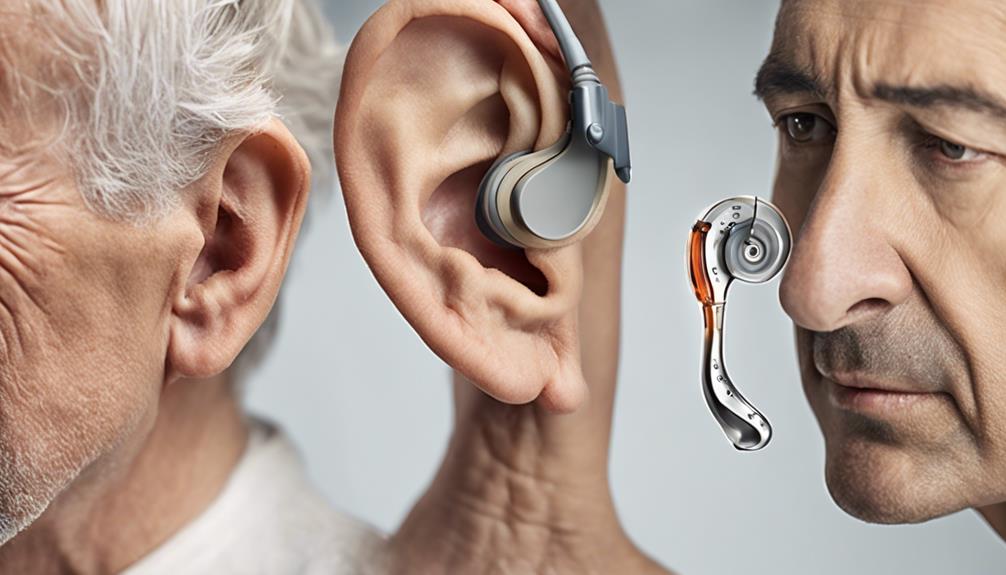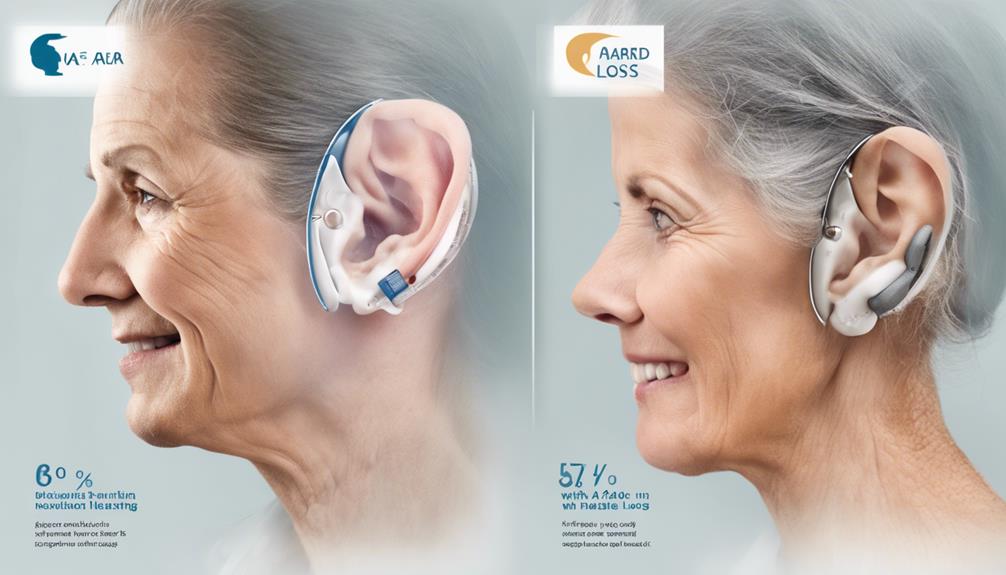Navigating the VA System
Understanding VA Hearing Loss Rating for Veterans
Journey into the intricate world of VA Hearing Loss Rating for Veterans and discover the impactful benefits awaiting those who seek clarity.

When delving into the intricacies of the VA Hearing Loss Rating system for Veterans, we are faced with a structure that requires careful examination and understanding.
The evaluation process, crucial for determining disability ratings, holds significant weight in determining a veteran's eligibility for benefits and treatment.
But how exactly do these ratings translate into tangible support for veterans? Let's explore the nuances and implications of VA hearing loss ratings together, shedding light on the path towards maximizing benefits and ensuring proper compensation for those who have served.
Key Takeaways
- VA uses a grid chart based on tests for disability ratings.
- Causes include loud noises, defective gear, and blast injuries.
- Service connection requires detailed evidence linking hearing loss to military service.
- Maximizing benefits involves proactive engagement and collaborative efforts with VA representatives.
VA Hearing Loss Rating Overview
In determining the severity of hearing loss in veterans, the VA assigns disability ratings based on auditory test results. These ratings, ranging from 0 to 100 percent, help determine the impact of hearing loss on daily life. Most veterans usually receive a 10% disability rating for hearing loss, but this can vary based on individual circumstances.
The VA utilizes a grid chart for impairment designation, ensuring that the disability rating aligns with the severity of the hearing loss. Veterans can seek VA disability compensation for hearing loss by undergoing specific tests conducted by a licensed audiologist. Establishing service connection is crucial, requiring a clear link between the current diagnosis of hearing loss and the veteran's time in service.
Additionally, providing evidence of how hearing loss affects daily functioning is essential for the VA to assess the disability rating accurately. By fulfilling these requirements, veterans can receive the compensation and support they deserve for their service-connected hearing impairments.
Determining Disability Ratings

Determining disability ratings for hearing loss involves assessing pure tone threshold test results administered by a licensed audiologist. When it comes to VA Disability Ratings for hearing loss, the process can be complex but essential for ensuring veterans receive the appropriate level of support.
- Impairment Designations: The VA employs a grid chart that categorizes different levels of hearing loss impairment based on test results and other factors.
- Severity of Hearing Loss: The severity of a veteran's hearing loss, as indicated by the pure tone threshold test, is a crucial factor in determining the disability rating.
- Speech Discrimination Tests: These tests help assess a veteran's ability to understand speech, which is vital in determining the impact of hearing loss on daily communication.
- 100% Disability Rating: While rare, veterans can receive a 100% disability rating for hearing loss if their condition significantly affects their quality of life and ability to work.
Understanding these aspects can help veterans navigate the process of obtaining the appropriate disability rating for service-connected hearing loss.
Causes of Hearing Impairments
After evaluating the severity of hearing loss through pure tone threshold tests, it's crucial to understand the various causes behind these impairments for veterans. Exposure to loud noises, such as gunfire exceeding 155 decibels, is a prevalent factor in hearing loss among veterans. Additionally, defective protective gear like 3M earplugs has also contributed to auditory impairments in military personnel.
The constant exposure to high noise levels from aircraft and equipment, particularly impacting pilots, is another significant cause of hearing impairments. Furthermore, veterans exposed to jet fuel may experience inner ear diseases and auditory processing issues, affecting their hearing abilities.
Blast injuries from explosions and IEDs can result in inner ear damage, leading to conditions like vertigo and tinnitus, further complicating the hearing health of veterans. Understanding these causes is essential for accurate assessments and appropriate VA Ratings for Hearing to support our veterans effectively.
Establishing Service Connection

To establish service connection for VA disability benefits related to hearing loss or tinnitus, veterans must provide compelling evidence linking their condition to their time served in the military. When seeking to establish this connection, veterans should consider the following steps:
- In-Service Event: Provide details of any incidents or exposure during military service that may have contributed to hearing loss or tinnitus.
- Current Diagnosis: Obtain a current medical diagnosis of hearing loss or tinnitus from a healthcare provider.
- Medical Nexus: Secure medical opinions or reports that clearly link the hearing impairment to the time spent in the military.
- Documentation: Gather all relevant documentation, including service records, medical reports, and any other evidence supporting the claim.
Maximizing VA Benefits
Maximizing VA benefits for hearing loss requires proactive engagement and thorough documentation to support your claim effectively. To enhance your VA claim, it's essential to provide accurate information about your hearing loss and follow recommended treatment plans diligently.
Additionally, including additional supporting evidence can strengthen your case and potentially lead to a higher disability rating. Collaborating with a qualified VA representative or attorney can significantly improve the outcome of your application for VA benefits.
In case of a less favorable decision, filing an appeal is crucial to potentially increase your benefits. Ensuring that all documentation and evidence are complete, compelling, and up-to-date is vital to maximize your chances of receiving the maximum benefits for your hearing loss.
Frequently Asked Questions
How Does the VA Determine Hearing Loss Ratings?
When evaluating hearing loss ratings, the VA considers pure tone threshold test results. Ratings range from 0 to 100 percent, with many veterans getting a 10% rating for tinnitus. These ratings affect eligibility for benefits and care.
Those with hearing loss in both ears may qualify for Special Compensation. The VA uses a grid chart to assign disability ratings based on impairment levels.
Is 30% Hearing Loss a Disability?
Oh, absolutely, a 30% hearing loss is considered a disability. It signifies a moderate level of impairment in hearing ability, which can lead to significant communication challenges.
This rating can greatly impact our daily lives and interactions, warranting support and accommodations to help navigate through these challenges.
VA benefits and compensation may be available for veterans with a 30% hearing loss disability rating.
How Do You Calculate Hearing Loss Disability?
When calculating hearing loss disability, we consider Puretone Audiometry Test results for specific frequencies in both ears along with Controlled Speech Discrimination Results. Examiners also note if the speech discrimination test is appropriate for the individual.
Monthly payment amounts are determined based on these test results, with the possibility of receiving 100% disability through Unemployability if applicable.
It's crucial to ensure accurate testing to determine the correct disability rating.
Is Tinnitus Conductive or Sensorineural?
Tinnitus can be conductive or sensorineural, depending on its root cause. Conductive hearing loss stems from issues in the outer or middle ear, while sensorineural hearing loss involves damage to the inner ear or auditory nerve.
Understanding this distinction is crucial as it impacts treatment options for tinnitus. If you're experiencing tinnitus, it's essential to consult with a healthcare professional to determine the underlying type of hearing loss for proper management.
Conclusion
As we continue on our journey to understand VA hearing loss ratings for veterans, we're reminded of the importance of seeking the benefits and treatment we deserve.
The process may seem daunting, but with the right support and guidance, we can navigate through it successfully.
Stay tuned for more tips and insights on how to maximize your VA benefits and improve your quality of life as a veteran.
The possibilities are endless, so don't give up hope just yet.
Jamie is one of the creative forces behind the words that resonate with our audience at Deaf Vibes. With a passion for storytelling and advocacy, Jamie delves into topics that matter deeply to the deaf and hard-of-hearing community. Jamie’s articles are crafted with empathy, insight, and a commitment to positive change, from exploring the latest advancements in hearing technologies to shedding light on the everyday challenges and victories of those within the community. Jamie believes in the power of shared stories to inspire action, foster understanding, and create a more inclusive world for everyone.
Navigating the VA System
Understanding Bilateral Hearing Loss VA Rating Criteria
Yearning for clarity on how the VA evaluates bilateral hearing loss? Uncover the key insights to help veterans navigate the rating criteria maze.

Exploring the details of the VA Rating Criteria for Bilateral Hearing Loss, we examine the intricate components that make up the foundation of disability assessments for veterans. Understanding the process that the VA utilizes to determine the level of hearing loss in both ears is crucial for veterans as they navigate the claims process.
By delving into the specific tests used and the range of potential ratings, we gain insight into how to present a strong case for compensation.
Stay tuned as we unravel the complexities of VA rating criteria for bilateral hearing loss, shedding light on the path to securing the benefits our veterans rightfully deserve.
Key Takeaways
- VA rating for bilateral hearing loss based on speech discrimination and pure tone tests.
- Ratings start at 10% and increase with severity, influencing benefits.
- Total hearing loss may qualify for Special Monthly Compensation (SMC).
- Comprehensive evaluation by an audiologist crucial for accurate rating.
Definition of Bilateral Hearing Loss
Bilateral hearing loss is a condition characterized by impairment in both ears, affecting an individual's ability to perceive sounds from various sources. Veterans frequently encounter this condition due to exposure during military service, such as gunfire, explosions, or hazardous environments. Diagnosing bilateral hearing loss necessitates a thorough evaluation by a licensed audiologist, including assessments like speech discrimination and pure tone threshold tests.
To file VA claims for bilateral hearing loss, veterans must establish a clear connection between their current condition and the in-service events that caused or worsened their hearing impairment. The VA rating criteria for bilateral hearing loss are stringent and require specific documentation to determine the severity of the condition accurately.
Understanding the nuances of how bilateral hearing loss is defined and assessed is crucial for veterans navigating the VA claims process to ensure they receive the appropriate recognition and support they deserve for their service-related hearing difficulties.
VA Rating Schedule Overview

When examining the VA Rating Schedule for hearing loss, one must consider specific criteria that evaluate the severity of hearing impairment in both ears. The VA rating schedule utilizes a combination of factors to determine the disability rating for bilateral hearing loss:
- Ratings are based on speech discrimination and pure tone threshold average test results for both ears.
- The VA assigns a Roman numeral designation on a grid chart to establish the disability rating.
- Veterans typically receive a 10% disability rating for bilateral hearing loss, with the potential for higher ratings depending on specific test outcomes.
- Bilateral hearing loss ratings play a crucial role in determining the level of compensation and benefits veterans may receive from the VA.
Understanding these components of the VA rating schedule is essential for accurately assessing the impact of bilateral hearing impairment on veterans' lives and ensuring they receive appropriate compensation and support.
Factors Influencing VA Ratings
Factors influencing VA ratings for hearing loss include a combination of speech discrimination and pure tone threshold average test results for both ears. The severity of bilateral hearing loss in each ear determines the disability rating percentage assigned by the VA.
By combining the ratings for both ears, the VA calculates the overall disability compensation for bilateral hearing loss. If individuals believe they deserve a higher rating, they can submit additional evidence, such as test results from a licensed audiologist, to support their claim.
In cases of total hearing loss in both ears, Special Monthly Compensation (SMC) may be granted in addition to regular disability compensation. Understanding how speech discrimination and pure tone threshold averages impact VA ratings is crucial for veterans seeking fair compensation for their bilateral hearing loss.
Impact of Hearing Loss Severity

The severity of hearing loss directly influences the disability rating assigned by the VA, impacting veterans' benefits and compensation. When evaluating hearing loss severity for VA disability rating purposes, several key factors come into play:
- Ratings are determined based on speech discrimination and pure tone threshold averages.
- More severe hearing loss results in higher disability ratings, potentially leading to increased compensation.
- Bilateral hearing loss in both ears can contribute to a higher disability rating due to the impact on overall hearing ability.
- The assessment of hearing loss severity is typically conducted by a licensed audiologist to ensure accuracy and consistency in determining the appropriate disability rating.
Understanding the implications of hearing loss severity on VA benefits is crucial for veterans, as it directly affects the level of compensation they may receive. For those experiencing significant hearing impairments, the disability rating criteria play a vital role in determining eligibility for additional support, such as unemployability benefits.
Evaluation Process for VA Rating
To evaluate bilateral hearing loss for VA rating, specific tests like the Maryland CNC Test and Pure Tone Audiometric test are utilized, with the VA employing a grid chart to assign a Roman numeral designation based on the degree of hearing impairment. The rating process considers speech discrimination and Puretone threshold averages to assign disability ratings accurately. Veterans must undergo a comprehensive hearing exam conducted by a licensed audiologist for a precise diagnosis. It's crucial to note that diagnoses solely by a primary care doctor are not considered sufficient evidence for VA claims related to hearing loss. Below is a table outlining the evaluation process for VA rating of bilateral hearing loss:
| Evaluation Process | Description | Importance |
|---|---|---|
| Maryland CNC Test | Evaluates speech discrimination ability to understand speech in noise environments. | Critical for VA assessment |
| Pure Tone Audiometric test | Measures hearing sensitivity across different frequencies to determine hearing thresholds. | Essential for rating |
| Comprehensive Hearing Exam | Conducted by a licensed audiologist to assess the full extent of hearing loss and its impact. | Crucial for accurate rating |
Frequently Asked Questions
How Does the VA Calculate Bilateral Hearing Loss?
We calculate bilateral hearing loss by combining results from both ears to determine a single disability rating. This rating is based on the average of pure tone thresholds and speech discrimination scores.
A grid chart assigns a Roman numeral designation according to the severity of the impairment. The most common rating for veterans with bilateral hearing loss is 10%.
Additional evidence can support a higher disability rating when warranted.
How Is Bilateral VA Rating Calculated?
We determine bilateral VA ratings by evaluating the Puretone threshold average and speech discrimination scores for both ears. These test results are combined to assign a single disability rating reflecting the severity of hearing loss in both ears.
Veterans can submit additional evidence to support a higher disability rating. The VA uses a percentage scale to rate bilateral hearing loss, ensuring fair evaluation and appropriate compensation for affected individuals.
What Is Bilateral Mild to Moderate Hearing Loss?
Bilateral mild to moderate hearing loss signifies a condition where both ears exhibit mild to moderate hearing difficulties. This can impede our ability to perceive sounds clearly, especially in noisy settings or conversations. Speech recognition and understanding may also be affected, leading to communication challenges.
Causes can vary from aging to noise exposure or medical issues. Individuals with this condition might find benefit from hearing aids or other assistive devices to enhance their hearing.
What Is the Most Common VA Rating for Hearing Loss?
We often see a 10% VA rating for hearing loss, which is quite common among veterans. This rating is typically given for mild to moderate hearing loss.
It's just one of the many ratings ranging from 0% to 100% based on the severity of the condition. Higher ratings or total hearing loss could lead to additional compensation.
It's important to understand how these ratings are determined for veterans dealing with hearing loss.
Conclusion
In conclusion, the VA rating criteria for bilateral hearing loss is crucial for veterans seeking disability benefits. Understanding the impact of hearing impairment in both ears and the factors influencing VA ratings is key to receiving appropriate compensation.
The evaluation process can be complex, but with the right evidence, veterans can potentially qualify for higher disability ratings.
Stay tuned for more insights on navigating the VA disability benefits system for hearing loss.
Jamie is one of the creative forces behind the words that resonate with our audience at Deaf Vibes. With a passion for storytelling and advocacy, Jamie delves into topics that matter deeply to the deaf and hard-of-hearing community. Jamie’s articles are crafted with empathy, insight, and a commitment to positive change, from exploring the latest advancements in hearing technologies to shedding light on the everyday challenges and victories of those within the community. Jamie believes in the power of shared stories to inspire action, foster understanding, and create a more inclusive world for everyone.
Navigating the VA System
How Does the VA Rate Hearing Loss for Veterans?
Keen to uncover the intricacies behind how the VA rates hearing loss for veterans?

Understanding how the VA assesses hearing loss in veterans can seem straightforward yet intricate at the same time.
From understanding the criteria used for evaluating hearing loss severity to uncovering the various factors that impact disability ratings, there's a complexity that demands attention.
Let's explore the nuances of how the VA calculates these ratings and what veterans should be mindful of when navigating this system for their benefit.
Key Takeaways
- VA rates hearing loss based on pure tone threshold tests.
- Disability ratings range from 0 to 100%.
- Severity impacts disability rating, up to 100%.
- Accurate diagnosis by audiologist crucial for VA compensation.
VA Hearing Loss Rating Criteria
When determining VA disability ratings for hearing loss, veterans are evaluated based on the results of pure tone threshold tests. These tests measure the softest sounds a person can hear at different frequencies.
The VA assigns disability ratings for hearing loss on a scale from 0 to 100 percent, with most veterans receiving a 10% rating. Using a grid chart, the VA designates impairment levels corresponding to different degrees of hearing loss, helping determine the appropriate disability rating.
To qualify for VA benefits, veterans must establish a connection between their hearing loss and their military service. This service connection is crucial in demonstrating that the hearing loss is related to conditions experienced during service.
Determining Hearing Loss Severity

Determining the severity of hearing loss for VA disability ratings relies on the results of specific tests conducted by licensed audiologists. The pure tone threshold test is a crucial tool in diagnosing hearing loss and assessing its severity. VA disability ratings are assigned based on a grid chart that correlates the test results with an impairment designation, ultimately determining the disability rating a veteran will receive. The severity of hearing loss directly impacts the disability rating granted by the VA, with veterans potentially receiving up to a 100% disability rating. Most commonly, veterans with hearing loss are rated at 10%. It is essential for veterans seeking VA compensation for hearing loss to undergo these specific tests administered by a licensed audiologist to ensure an accurate diagnosis and appropriate disability rating.
| Hearing Loss Severity | Impairment Designation | VA Disability Rating |
|---|---|---|
| Mild | Minimal | 0-10% |
| Moderate | Moderate | 30-60% |
| Severe | Marked | 70-100% |
Understanding VA Compensation Levels
Understanding the VA's hierarchy of compensation levels for hearing loss is crucial for veterans navigating the disability claims process. The VA rates hearing loss on a scale from 0 to 100%, with most veterans typically falling within the 0-10% range.
The severity of hearing loss and its impact on daily life play a significant role in determining the disability compensation level assigned by the VA. Veterans with profound hearing loss may receive a higher disability rating, potentially up to 100%, based on specific criteria, such as pure tone threshold tests, and the level of functional impairment experienced.
The VA utilizes these assessments to accurately gauge the degree of hearing loss and assign appropriate compensation levels to eligible veterans. Having a clear understanding of the VA rating system for hearing loss is essential for veterans to effectively file disability claims and secure the benefits they rightfully deserve.
Factors Impacting VA Hearing Loss Ratings

Factors influencing VA hearing loss ratings include the results of pure tone threshold tests administered by licensed audiologists. These tests assess the severity of sensorineural hearing loss, which is common among veterans due to noise exposure during service.
Additionally, speech discrimination ability plays a crucial role in determining the impact of hearing loss on communication. Veterans experiencing tinnitus may also receive higher disability ratings, as this condition often accompanies hearing loss and can exacerbate functional impairment.
The VA utilizes a grid chart to match the degree of impairment designated by the test results with specific disability ratings, ranging from 0% to 100%. Individuals with profound hearing loss or significant functional limitations are more likely to receive higher disability ratings, reflecting the greater impact of their condition on daily life activities.
Understanding these factors is essential for veterans seeking an accurate VA rating for their hearing loss.
Tips for Successful VA Claims
To increase the likelihood of a successful VA disability claim for hearing loss, it's crucial to submit a well-documented claim supported by evidence of in-service noise exposure. Providing a current diagnosis of hearing loss from a licensed audiologist is essential for establishing service connection and obtaining VA benefits.
Including a detailed nexus opinion linking the in-service noise exposure to the current hearing loss diagnosis strengthens the claim's validity for VA disability compensation. During Compensation & Pension examinations, ensuring accurate information about the impact of hearing loss on daily life can support the approval of the claim.
Additionally, utilizing lay testimony from family members or fellow service members to describe the noticeable effects of hearing loss can provide additional evidence for a successful VA claim. By following these tips and presenting a comprehensive case with supporting documentation, individuals can enhance their chances of a favorable outcome in their VA disability claim for hearing loss.
Frequently Asked Questions
How Does VA Determine Hearing Loss Rating?
We determine hearing loss ratings by assessing pure tone threshold test results. A licensed audiologist conducts these tests to determine the severity of the hearing loss.
Ratings range from 0 to 100 percent, with most veterans typically receiving a 10% rating for hearing loss.
The VA utilizes a grid chart to assign disability ratings, with ratings exceeding 10% being less common.
What Are the 4 Types of Hearing Loss?
We've four main types of hearing loss:
- Conductive hearing loss stems from issues in the outer or middle ear, hindering sound from reaching the inner ear.
- Sensorineural hearing loss, the most prevalent type, results from damage to the inner ear or auditory nerve.
- Mixed hearing loss combines aspects of both conductive and sensorineural hearing loss.
- Lastly, Central hearing loss arises from problems in the central nervous system affecting sound processing.
What Is the Configuration of Hearing Loss?
When considering the configuration of hearing loss, it's crucial to understand the specific pattern of hearing loss across different frequencies. This can include flat, sloping, rising, or cookie-bite patterns.
These configurations impact speech understanding and communication abilities differently. Through audiometric testing, we determine the configuration, which aids in selecting appropriate hearing aids or treatment options.
Understanding these patterns is vital in providing effective support for individuals with hearing loss.
Is 30% Hearing Loss a Disability?
Yes, 30% hearing loss is considered a disability. It signifies a moderate level of impairment in hearing ability, impacting communication and daily functioning significantly. Veterans with this rating may struggle to hear conversations in noisy settings, necessitating aids for assistance.
The VA acknowledges 30% hearing loss as a substantial impairment warranting compensation and support. This disability rating reflects a genuine need for assistance due to the impact on hearing ability.
Conclusion
In conclusion, understanding how the VA rates hearing loss for veterans is crucial for ensuring proper compensation and treatment. By carefully considering the criteria, severity, compensation levels, and factors impacting ratings, veterans can navigate the claims process more effectively.
It's important to gather all necessary evidence and documentation to support your case. Stay tuned for more tips and insights on maximizing your VA benefits.
Jamie is one of the creative forces behind the words that resonate with our audience at Deaf Vibes. With a passion for storytelling and advocacy, Jamie delves into topics that matter deeply to the deaf and hard-of-hearing community. Jamie’s articles are crafted with empathy, insight, and a commitment to positive change, from exploring the latest advancements in hearing technologies to shedding light on the everyday challenges and victories of those within the community. Jamie believes in the power of shared stories to inspire action, foster understanding, and create a more inclusive world for everyone.
Navigating the VA System
How Much Hearing Loss for VA Disability: A Guide
Unveil the mystery of how much hearing loss is needed for VA disability benefits, a crucial guide to veterans' well-being.

When dealing with VA disability, understanding the evaluation process for hearing loss is a crucial step. Knowing the specific criteria for qualifying for VA benefits is essential for receiving the necessary support.
By unraveling the nuances of eligibility criteria, evaluation processes, and potential compensation, we shed light on a crucial aspect of veterans' well-being. Join us in uncovering the significance of this guide to empower and assist those who have served our nation.
Key Takeaways
- VA disability ratings for hearing loss range from 0% to 100% based on severity and impact.
- Recognition of sensorineural, conductive, or mixed hearing loss types is crucial for VA evaluation.
- Filing accurately with supporting evidence and detailing the impact enhances approval chances.
- Consistent use of treatment, like hearing aids, and establishing service connection are vital for maximizing benefits.
VA Disability Criteria for Hearing Loss
When evaluating VA Disability for Hearing Loss, the criteria used includes a rating scale from 0% to 100% based on factors such as puretone thresholds, speech discrimination, diagnosis, and the cause of the hearing impairment. This comprehensive approach allows for a thorough assessment of veterans' hearing abilities and the impact of any loss on their daily lives. The VA recognizes that hearing loss can significantly affect communication, relationships, and overall quality of life for veterans.
The VA's disability ratings for hearing loss are crucial in determining the level of compensation veterans may receive. These ratings take into account the severity of hearing loss, its impact on speech discrimination, and whether the impairment is service-connected. By considering both ears together, the VA aims to provide fair and accurate ratings that reflect the overall impact of hearing loss on an individual. Understanding the VA's criteria for rating hearing loss is essential for veterans seeking medical and financial support for their service-related disabilities.
Types of Recognized Hearing Loss

Recognizing various types of hearing loss is essential for determining eligibility for VA disability benefits, with the VA acknowledging sensorineural, conductive, and mixed forms of hearing impairment.
Sensorineural hearing loss, the most common type recognized by the VA, affects the inner ear or auditory nerve pathways, often caused by aging or exposure to loud noises.
Conductive hearing loss, stemming from blockages in the outer or middle ear, is also considered for VA disability benefits. This type may result from issues like earwax buildup, infections, or abnormalities in the ear structure.
Mixed hearing loss, which combines sensorineural and conductive elements, is evaluated by the VA when determining disability compensation. Furthermore, blast injuries or trauma can lead to any of these recognized types of hearing loss, underlining the importance of thorough assessment for veterans seeking VA support.
Understanding these distinctions is crucial for accurately assessing and addressing veterans' hearing-related disabilities.
VA Evaluation Process for Hearing Loss
In evaluating hearing loss for VA disability benefits, the process includes conducting speech discrimination and puretone audiometry tests. These tests help assess the severity of the hearing impairment and determine the appropriate disability ratings for hearing loss. The VA considers various factors such as puretone thresholds, speech discrimination ability, diagnosis, and the cause of the hearing loss when evaluating a veteran's condition.
It's important to note that hearing loss and tinnitus are evaluated separately during this process. The evaluation takes into account both ears together to determine the overall impact on hearing. Understanding the VA evaluation process for hearing loss is crucial for veterans seeking service-connected disability benefits.
This evaluation is typically conducted as part of a Compensation and Pension (C&P) exam to assess the extent of hearing loss and its impact on daily life, ensuring veterans receive the VA benefits they deserve.
Filing for VA Hearing Loss Benefits

To apply for VA hearing loss benefits, veterans can submit a claim online, in person, or by mail along with the necessary military service information. When filing a VA hearing loss claim, it's essential to include supporting evidence such as statements from family or coworkers to strengthen the application.
VA representatives carefully review these applications, schedule Compensation and Pension (C&P) exams as needed, and assess eligibility for disability benefits based on the information provided. Accuracy in detailing the impact of hearing loss, adherence to recommended medical care, and the submission of additional supporting evidence are crucial for a successful claim.
For veterans with hearing loss, obtaining compensation for hearing loss benefits can significantly improve their quality of life. Seeking assistance from a qualified VA representative or attorney can further enhance the chances of maximizing VA hearing loss benefits and navigating the claims process efficiently.
Maximizing VA Hearing Loss Benefits
Maximizing VA hearing loss benefits requires meticulous documentation of the impact of the condition and adherence to prescribed treatment plans.
For age-related hearing loss, providing comprehensive medical evidence detailing the functional impact on daily activities is crucial.
The VA Rating for Hearing is determined based on the severity of the hearing loss, with benefits varying across different hearing loss ranges.
Demonstrating the consistent use of hearing aids can support your VA disability claim, showcasing the efforts made to mitigate the impairment.
Additionally, establishing a clear service connection between your hearing loss and military service through relevant records enhances your case for benefits.
Including detailed information on how the hearing loss affects communication, work, and quality of life can further strengthen your application.
Working closely with a qualified VA representative or attorney can offer valuable guidance in maximizing your VA disability benefits for hearing loss.
If needed, appealing for a higher disability rating can also be pursued to ensure you receive the appropriate level of support.
Frequently Asked Questions
What Is the Average VA Rating for Hearing Loss?
We can confirm that the average VA rating for hearing loss is 10%.
This rating signifies mild to moderate impairment, reflecting the common experience among veterans and its impact on daily life.
Those with this rating may face challenges in specific listening environments and could benefit from interventions such as hearing aids.
The 10% rating indicates the level of functional limitation due to hearing loss as determined by the VA.
Is 30% Hearing Loss a Disability?
We believe that a 30% hearing loss is considered a disability by the VA.
This level of impairment can significantly impact daily life and communication abilities.
Veterans with a 30% hearing loss rating may struggle to hear conversations in noisy settings or understand speech without help.
Accommodations and support are often necessary for individuals with this level of hearing loss to manage their condition effectively.
What Is the C&P Exam for Hearing Loss?
The C&P exam for hearing loss is a comprehensive evaluation by the VA. It involves tests like speech discrimination and puretone audiometry to determine the severity of one's hearing impairment.
This exam is crucial in deciding disability ratings and eligibility for VA benefits related to hearing loss. Results from the C&P exam provide insights into how hearing loss impacts daily life and functioning.
It's a standard part of the process for veterans seeking compensation for service-connected hearing issues.
How Do You Calculate Hearing Loss Disability?
When calculating hearing loss disability, we rely on puretone audiometry tests to determine the severity. These tests establish thresholds that guide the VA in assigning disability ratings.
Additionally, speech discrimination testing is crucial in evaluating communication impairment. Our process considers the degree of hearing loss and speech understanding to accurately assess disability.
Conclusion
As we unravel the complexities of VA disability for hearing loss, we uncover a world of possibilities for veterans seeking support. Understanding the criteria, types, evaluation process, and filing procedures is just the beginning.
By maximizing VA benefits, veterans can unlock a realm of opportunities for financial assistance and medical care. Stay tuned as we continue to explore the intricate web of VA disability ratings and the journey towards reclaiming the quality of life for those who've served.
Jamie is one of the creative forces behind the words that resonate with our audience at Deaf Vibes. With a passion for storytelling and advocacy, Jamie delves into topics that matter deeply to the deaf and hard-of-hearing community. Jamie’s articles are crafted with empathy, insight, and a commitment to positive change, from exploring the latest advancements in hearing technologies to shedding light on the everyday challenges and victories of those within the community. Jamie believes in the power of shared stories to inspire action, foster understanding, and create a more inclusive world for everyone.
-

 Navigating the VA System4 weeks ago
Navigating the VA System4 weeks agoVA Hearing Loss Rating Chart: Understanding Disability Compensation
-

 Therapies and Interventions3 months ago
Therapies and Interventions3 months ago10 Auditory Processing Goals for Effective Speech Therapy
-

 Living with Hearing Loss2 months ago
Living with Hearing Loss2 months ago10 Deaf-Friendly Dating Sites to Find Your Perfect Match
-

 Sign Language3 months ago
Sign Language3 months agoSign Language Emoji Translator: How to Communicate With Gestures
-

 Tinnitus1 month ago
Tinnitus1 month agoVA's Rating System for Tinnitus and Hearing Loss Explained
-

 Navigating the VA System3 weeks ago
Navigating the VA System3 weeks agoUnderstanding Bilateral Hearing Loss VA Rating Criteria
-

 Vetted1 month ago
Vetted1 month ago15 Best Oticon Hearing Aids to Improve Your Hearing in 2024
-

 Living with Hearing Loss2 months ago
Living with Hearing Loss2 months agoAn Introduction to Deaf Culture: Understanding the Basics



















